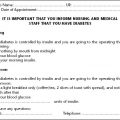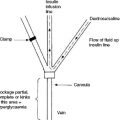Key points
- Practice nurses are playing an increasingly important role in diabetes care.
- Well established collaboration and referral procedures among health services and health service providers is essential.
- Community, practice and home care nurses are in an ideal position to deliver preventative health care education.
Introduction
Community care enables technical and professional care to be provided to acutely and chronically ill patients at home. The provision of specific services will be influenced by the home environment, the person’s condition and capabilities, and available home support services. A nursing care plan should be prepared to complement the medical management plan.
Supporting people to enable them to remain at home is an important consideration of diabetic management. Practice nurses and community and home-care nurses play an important role in this respect.
These nurses also play and important role in supporting carers and identifying carer distress. A recent Australian study showed carers have lowest well being of any large societal group (Australian Unity 2008). Significantly, well being decreases as the number of hours spent providing care increases and women carers have lower levels of well being than male carers. The Australian Unity survey showed unpaid, largely family, carers provide ∼$30.5 billion worth of care per year. Many carers have high levels of worry about their financial situations and their personal health that often results in depression. They often make significant lifestyle, family and work sacrifices in order to provide care. Many do not receive care for their own health issues, which include depression, chronic pain, injuries attributable to caring and many are overweight, which increases their risk of obesity-related diseases.
Diabetes-related care in the home includes:
- Preparing insulin doses.
- Administering insulin.
- Performing blood glucose tests.
- Assessing the general condition of the patient.
- Supporting the continuing education of the patient and of family/carers.
- Attending to wound dressings.
- Attending to personal hygiene.
- Assisting with medication management.
- Detecting deteriorating metabolic control, and functional and cognitive ability.
Making clinical decisions about the patient in the home situation without advice and support can be stressful and difficult. In addition, the home situation must be carefully assessed to ascertain how to obtain access to the home, and the correct address and telephone number. The safety of the nurse is an important consideration and issues such as the surrounding environment and household members should be assessed beforehand, if possible. The service base should have some idea of the route the nurse is likely to take. Other information (e.g. presence of dogs) should also be noted.
This chapter outlines the important diabetes-related information needed to gauge whether medical assessment is necessary.
How to obtain advice
It is important for home care and domiciliary nursing bodies to establish open communication links with the referring agency or practitioner.
The referring agency should be the first point of contact for advice.
General points
- vision
- manual dexterity
- comprehension.
Diabetic problems commonly encountered in the home
Nursing actions
- temperature
- pulse
- respiration and presence of respiratory distress
- blood pressure
- colour.
- frequency
- burning
- scalding
- itching.
Interpreting the blood glucose level
To assess the diabetic status one must first ascertain whether the patient is in danger because of the blood glucose level. Ascertain:
- The present level.
- The usual blood glucose range.
- Why the blood glucose is outside the usual range. Whether the patient has suffered any illness, committed a dietary indiscretion, commenced on a new medication, missed a medication dose, or is using a complementary or self-prescribed medication.
- Whether it is likely to go up or down.
When ascertaining the blood glucose level check whether:
- The test was performed correctly.
- There was enough blood on the strip; if using a meter that the meter was calibrated and used correctly.
- The strips have exceeded the expiry date (see Chapter 4, Monitoring 1: blood glucose).
- The patient has commenced any new medication that could alter the blood glucose level (see Chapter 3).
The patient may require attention if the blood glucose level is:
- Low – hypoglycaemia <3 mmol/L.
- High – hyperglycaemia >17 mmol/L for a significant number of tests.
Hypoglycaemia
For more detailed information see Chapter 8.
- glucose gel
- orange juice
- tea/coffee with sugar
- jelly beans.
If severe follow the procedure for managing unconscious hypoglycaemia ( Chapter 8). IM glucagon can be administered if it is available. If not, manage the airway and seek medical or ambulance assistance.
Discuss recognition and treatment of hypoglycaemia with patient and family. Ensure that the person and/or their family and carers know how to manage hypoglycaemia, that there is appropriate food/fluids to manage hypoglycaemia and they know who to call in an emergency.
Hyperglycaemia
For more detailed information, see Chapter 7. Ascertain:
- How long the blood glucose level has been elevated.
- Whether the patient is unwell.
- Whether there are any symptoms of hyperglycaemia, for example, polyuria, polydipsia, thirst or lethargy.
- Whether there are ketones present in the urine.
If moderate/heavy ketones are detected seek medical advice (this usually only occurs in Type 1 people).
Check for any obvious source of infection:
- Urinary
- Foot ulcer wound
- Cold or flu.
Counsel the patient about managing at home when unwell. (Patient information guidelines are shown in Chapter 5.) The important points are that the patient should:
- Continue to take insulin or OHAs.
- Maintain fluid and carbohydrate intake.
- Test and record blood glucose regularly, for example, 2 to 4 hourly.
In addition:
Stay updated, free articles. Join our Telegram channel

Full access? Get Clinical Tree







